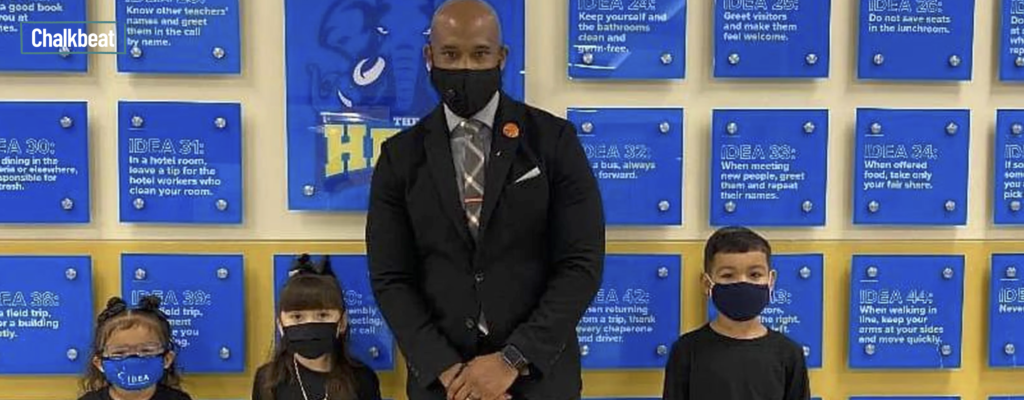
Gerald Boyd, principal of IDEA Hardy, with some of his students. Courtesy of IDEA Public Schools
This article originally appeared on Chalkbeat
Most educators can pinpoint a moment in their lives when they realize what impact they want to make on their students’ lives. Many take inspiration from Nelson Mandela, who once said, “education is the most powerful weapon which you can use to change the world.” Those words continue to echo loudly, especially as we take a moment to reflect on Black History Month and celebrate the contributions and achievements made by those in our community and across the country.
:no_upscale()/cdn.vox-cdn.com/uploads/chorus_asset/file/22331994/boyd_gerald.jpeg)
Gerald Boyd Courtesy of IDEA Public Schools
Let me tell you why this is so important.
I am from Houston and was the first in my family to graduate high school and attend college. When I got to the University of Texas at Austin, alongside 10 of my high school classmates, I saw first-hand the inequities in access and quality of education. During my first semester, eight of us were put on academic probation, and four years later, only two of us — myself included — graduated. This showed me that we didn’t have the tools and resources to succeed, and without support, most of us had lost faith that we could be successful.
In my second year at UT Austin, I joined the elite Black Greek lettered organization, Kappa Alpha Psi. For the first time, I witnessed young, Black men achieve. One of our brothers graduated from Harvard Law School and another graduated from Nebraska Law. When I saw them succeed, I believed I could, too. This inspired me to join Teach For America after finishing college to teach in my hometown of Houston.
I made the decision to run two schools 15-minutes away from where I grew up. Since this is where I was raised, I understand what many of the students in my community are up against because I’ve experienced much of it myself. Many students in second grade were reading at a kindergarten level, but I knew that with the right support and intervention, they’d be able to succeed. Part of that means being able to show my kids what success looks like, and that it is within reach for them, too.
However, few schools across the country have diverse teaching workforces that represent the student bodies they serve. For instance, recent federal data shows that 79% of public school teachers were white, and less than 7% were Black. Public charter schools in Texas, however, employ significantly more teachers of color than traditional district schools. For instance, about 1 in 4 charter teachers are Black compared to 1 in 25 teachers at district schools.
Students of color need to know that success is possible for them, which cannot happen if we are sidelining educators of color. It should be a top priority to support educators of color determined to pay it forward. That is how we can help the next generation of leaders of color thrive.
We need to make sure that educators of color have mentors who can uplift them and that our leadership teams are diverse. This past year, I was proud to train school leaders on what it means to lead a school and a community. Mentorship like this ensures more leaders of color can succeed and uplift others. Our educators should feel empowered to bring their identities and their stories to their jobs to show up for themselves and our kids. This means that our teachers can talk openly about difficult topics in their classrooms, and our students know that they can turn to their teachers and school leaders for guidance.
Additionally, flexibility around teacher certification — a long, expensive process that research shows doesn’t lead to higher student achievement — would also help more educators of color enter the profession. This would remove the barriers that make it more difficult for people of color to become teachers. Take a look at Texas. Public charter schools here, along with traditional school districts that apply to be Districts of Innovation, are able to hire non-certified teachers in certain subjects and provide them with high-quality training throughout their careers.
As this year’s Black History Month comes to an end and we think about ways to better foster equity in all parts of society, we cannot forget about the classroom. When our children walk into the school building, they should see themselves reflected in their teachers, their principals, and their school staff. But it is going to take more than individual educators to make systems change. We must all be committed to ensuring that every student has the necessary tools and opportunities to flourish.
The turning point in my college career was when I witnessed other Black students and leaders around me achieving things that I had not imagined possible for myself. We must prioritize our students of color by empowering educators who have walked in their shoes and whom they can look to for inspiration and guidance.
The future generation is counting on us.
Gerald Boyd is the executive principal, IDEA Hardy in Houston.

One way to significantly increase the number of Black teachers is to encourage college students to major in education and take the praxis exams early in their college careers. It is heartbreaking to see Black college grads who do not have education degrees settle for low paying paraprofessional positions in a school because they majored in psychology, criminal justice, or business administration and cannot find jobs. A major in special education instead of psychology would have made them employable at a premium. Any education major would have set themselves up for a decent job. If they took the praxis early in their college career, they would have had time to address any deficiency failing to pass the praxis uncovered.